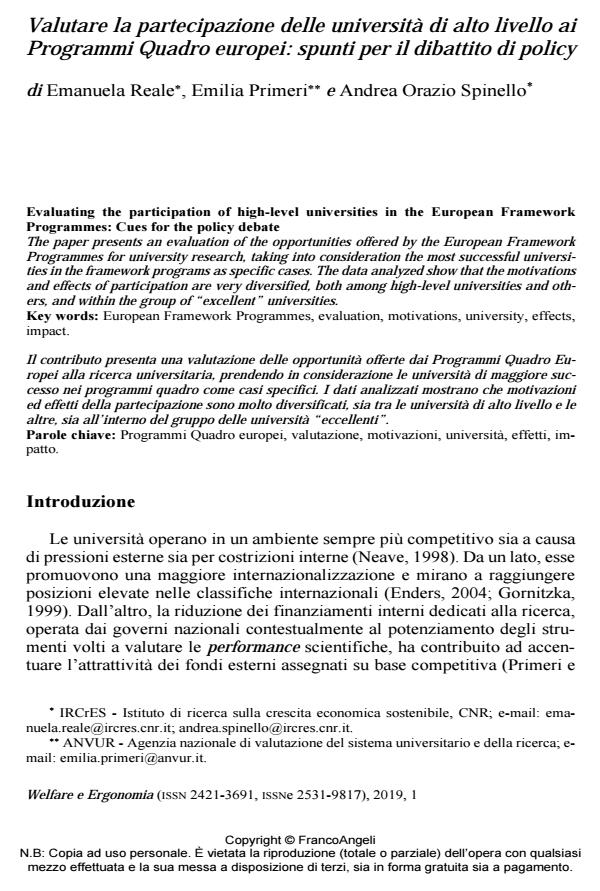Valutare la partecipazione delle università di alto livello ai Programmi Quadro europei: spunti per il dibattito di policy
Titolo Rivista WELFARE E ERGONOMIA
Autori/Curatori Emanuela Reale, Emilia Primeri, Andrea Orazio Spinello
Anno di pubblicazione 2020 Fascicolo 2019/1 Lingua Italiano
Numero pagine 12 P. 43-54 Dimensione file 189 KB
DOI 10.3280/WE2019-001005
Il DOI è il codice a barre della proprietà intellettuale: per saperne di più
clicca qui
Qui sotto puoi vedere in anteprima la prima pagina di questo articolo.
Se questo articolo ti interessa, lo puoi acquistare (e scaricare in formato pdf) seguendo le facili indicazioni per acquistare il download credit. Acquista Download Credits per scaricare questo Articolo in formato PDF

FrancoAngeli è membro della Publishers International Linking Association, Inc (PILA)associazione indipendente e non profit per facilitare (attraverso i servizi tecnologici implementati da CrossRef.org) l’accesso degli studiosi ai contenuti digitali nelle pubblicazioni professionali e scientifiche
Il contributo presenta una valutazione delle opportunità offerte dai Programmi Quadro Eu-ropei alla ricerca universitaria, prendendo in considerazione le università di maggiore suc-cesso nei programmi quadro come casi specifici. I dati analizzati mostrano che motivazioni ed effetti della partecipazione sono molto diversificati, sia tra le università di alto livello e le altre, sia all’interno del gruppo delle università "eccellenti".;
Keywords:Programmi Quadro europei, valutazione, motivazioni, università, effetti, impat-to.
- Altbach P.G., Reisberg L. and Rumblwey L.E. (2009). Trends in Global Higher Education: Tracking an Academic Revolution. A Report Prepared for the UNESCO 2009 World Conference on Higher Education. United Nations Educational, Scientific and Cultural Organization.
- Arrow K.J. (1993). Excellence and Equity in Higher Education. Education Economics, 1(1): 5-12. DOI: 10.1080/09645299300000002
- Breschi S. e Cusumano L. (2004). Unveiling the texture of a European Research Area: emergence of oligarchic networks under EU framework programmes. International Journal of Technology Management, 8: 747-772. DOI: 10.1504/IJTM.2004.004992
- Ciffolilli A., Colombelli A., Primeri E., Reale E., Scellato G., Bannò M., Caviggioli F., Condello S., De Marco A.M., Spinello A.O., Ughetto E., Scherngell T., Heller-Schuh B. and Wolleb E. (2016). An analysis of the role and engagement of universities with regard to participation in the Framework Programme, Final Report. Luxembourg: Publications Office of the European Union.
- Enders J. (2004). Higher education, internationalization and the nation-state: recent developments and challenges to governance theory. Higher Education, 47: 365-370. DOI: 10.1023/B:HIGH.0000016461.98676.30
- Geuna A. (1998). Determinants of university participation in EU-funded R&D cooperative projects. Research Policy, 26: 677-687. DOI: 10.1016/S0048-7333(97)00050-4
- Geuna A. (2001). The changing rationale for European University research funding: are there negative unintended consequences. Journal of Economic Issues, 35: 607-632. DOI: 10.1080/00213624.2001.11506393
- Gornitzka A. (1999). Governmental policies and organisational changes in higher education. Higher Education, 38: 5-31. DOI: 10.1023/A:100370321
- Guri S. (1986). Equality and excellence in higher education – Is it possible? Higher Education, 15(1): 59-71. DOI: 10.1007/BF00138092
- Henriques L., Schoen A. and Pontikakis D. (2009). Europe’s top research universities in FP6: scope and drivers of participation. Luxembourg: Office for Official Publications of the European Communities.
- Lascoumes P. et Le Galès P. (2005). Gouverner par les instruments. Paris: Les Presses de Sciences Po.
- Lepori B. and Reale E. (2012). S&T indicators as a tool for formative evaluation of research programs. Evaluation, 18(4): 451-465. DOI: 10.1177/1356389012460961
- Lepori B., Veglio V., Heller-Schuh B., Schnergell T. and Barber M. (2015). Participation to European Framework Programs of higher education institutions and their association with organizational characteristics. Scientometrics, 105(3): 2149-2178. DOI: 10.1007/s11192-015-1768-2.
- Luukkonen and Nedeva (2010). Towards understanding integration in research and research policy. Research Policy, 39(5): 674-686.
- Molas-Gallart J. and Davies A (2006). Toward theory-led evaluation – the experience of European science, technology and innovation policies. American journal of evaluation, 27: 64-82. DOI: 10.1177/1098214005281701
- Neave G. (1998). The Evaluative State Reconsidered. European Journal of Education, 33(3): 265-284.
- Nokkala T., Heller-Schuh B. and Paier, M. (2011). Ranking Lists and European Framework Programmes: Does University Status Matter for Performance in Framework Programmes? In: Teixeira P. and Dill D., editors, Public Vices, Private Virtues? Assessing the Effects of Marketization in Higher Education. Rotterdam: Sense Publishers.
- Olechnicka A., Ploszaj A. and Dorota Celińska-Janowicz (2019). The Geography of Scientific Collaboration. London and New York: Routledge.
- Primeri E. (2008). L’internazionalizzazione della ricerca nelle istituzioni scientifiche pubbliche. In: Reale E., a cura di, La valutazione della ricerca pubblica. Un’analisi della Valutazione Triennale della Ricerca. Milano: FrancoAngeli.
- Primeri E. and Reale E. (2012). How Europe Impacts on Academic Research: The Transformative Potential of the European Framework Programmes. In: Vukasović M., Maassen P., Nerland M., Stensaker B. and Stensaker B., editors, Effects of Higher Education Reforms: Change Dynamics. Rotterdam: Sense Publishers.
- Reale E., Nedeva M., Thomas D. and Primeri E. (2014). Evaluation through impact: a different viewpoint. Fteval Journal for Research and Technology Policy Evaluation, 39: 36-41
Emanuela Reale, Emilia Primeri, Andrea Orazio Spinello, Valutare la partecipazione delle università di alto livello ai Programmi Quadro europei: spunti per il dibattito di policy in "WELFARE E ERGONOMIA" 1/2019, pp 43-54, DOI: 10.3280/WE2019-001005